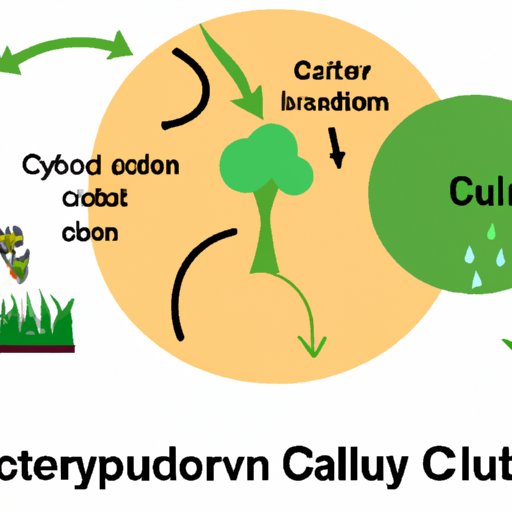Introduction
Photosynthesis is a complex process that enables plants to convert sunlight into energy through a series of chemical reactions. The Calvin Cycle is a key component of this process, helping to create food for the plant. In this article, we will provide a comprehensive guide to the Calvin Cycle, breaking down the steps involved in the process and explaining the importance of this process in the overall balance of life on earth.
The Calvin Cycle: A Comprehensive Guide To Photosynthesis
The Calvin Cycle is the process during which plants convert carbon dioxide into glucose. This cycle takes place in the stroma of the chloroplasts, which are organelles found in plant cells. The main function of the Calvin Cycle is to produce food using energy from the sun. This food is created in the form of glucose, which the plant uses for energy and growth.
The process of the Calvin Cycle begins with carbon fixation. During this process, carbon dioxide is converted into an organic compound called RuBP, which is short for ribulose 1,5-bisphosphate. Enzymes called Rubisco catalyze this process, which is the first step in the Calvin Cycle.
The second step in the Calvin Cycle is the reduction phase. During this phase, ATP and NADPH, which are products of the light-dependent reactions, are used to reduce the organic compound created during carbon fixation. This reduction creates a molecule called G3P, which is a three-carbon sugar.
The final step in the Calvin Cycle is the regeneration phase. During this phase, the remaining G3P molecules are used to regenerate RuBP. This regeneration allows the process to continue and create more glucose.
Breaking Down the Calvin Cycle: Understanding the Science Behind Photosynthesis
The Calvin Cycle is a complex process that involves various chemical reactions. During the carbon fixation phase, Rubisco catalyzes the reaction between carbon dioxide and RuBP, creating an unstable six-carbon compound that immediately breaks down into two three-carbon molecules called PGA.
During the second phase of the Calvin Cycle, ATP and NADPH, which are products of the light-dependent reactions, are used to reduce the PGA to G3P. This reduction involves the transfer of a hydrogen ion from NADPH to the PGA molecule. This transfer creates a chemical bond between the two molecules, which creates G3P.
In the final phase of the Calvin Cycle, the remaining G3P molecules are used to regenerate RuBP. This phase is essential to the continuation of the cycle, as it allows more carbon dioxide to be fixed and more glucose to be created.
Uncovering the Properties of the Calvin Cycle & Its Relation to Carbon Fixation
The Calvin Cycle is closely tied to carbon fixation, which is the process of converting carbon dioxide into organic compounds. During the carbon fixation phase of the Calvin Cycle, Rubisco catalyzes the reaction between carbon dioxide and RuBP, creating an unstable six-carbon compound that immediately breaks down into two three-carbon molecules called PGA.
Carbon fixation is essential to the survival of plants, as it allows them to create glucose, which they use for energy and growth. Additionally, carbon fixation has an important role in reducing the levels of carbon dioxide in the atmosphere, as it allows plants to remove the gas from the air and store it in a stable, organic form.
The Importance of the Calvin Cycle to the Ecosystem
The Calvin Cycle is a crucial part of the overall balance of life on earth. Through the process of photosynthesis, plants create oxygen and glucose, which provide food and energy for various organisms. Additionally, the Calvin Cycle plays an essential role in reducing the levels of carbon dioxide in the atmosphere. Without the Calvin Cycle and photosynthesis, life on earth as we know it would not exist.
The Calvin Cycle also has an important role in the food chain. By creating glucose, plants provide a food source for herbivores and omnivores. These animals, in turn, provide food for carnivores, creating a complex and interconnected web of life in the ecosystem.
The Future of Agriculture: How The Calvin Cycle is Revolutionizing Crop Yield
Scientists are constantly studying the properties of the Calvin Cycle to find ways to enhance crop yields. By understanding the process of photosynthesis and the role of the Calvin Cycle, researchers can develop crop varieties that are more efficient at converting energy from the sun into food. Additionally, scientists are exploring alternative methods of carbon fixation to create crops that are more sustainable and environmentally friendly.
Research studies have shown that by optimizing the Calvin Cycle, crop yields can be enhanced by up to 50%. These advancements have the potential to improve food security around the world and reduce the impact of agriculture on the environment.
Conclusion
The Calvin Cycle is a vital process in the overall balance of life on earth. Through photosynthesis, plants create oxygen and glucose, which provide food and energy for various organisms, and remove carbon dioxide from the atmosphere. By optimizing and studying the properties of the Calvin Cycle, researchers are opening up new possibilities for enhancing crop yields and improving food security. It is essential that we continue to study and understand this process to ensure a sustainable future for our planet.
